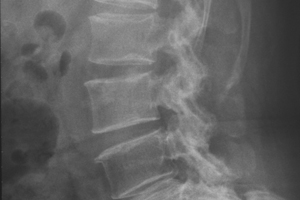THE authors of a new US study say older women with normal bone mineral density may not need repeat osteoporosis screening for 15 years, while those with advanced osteopenia should be screened annually.
The study, published in the New England Journal of Medicine, analysed data from 4957 women aged 67 years or more without a history of hip or clinical vertebral fracture or of treatment for osteoporosis. They were followed prospectively for up to 15 years. (1)
Baseline bone mineral density (BMD) emerged as the most important factor in determining how often a woman should be screened.
The authors estimated the testing interval for women with varying baseline BMD. The testing interval was defined as the estimated time for 10% of the women to make the transition to osteoporosis before having a hip or clinical vertebral fracture.
The estimated BMD testing interval was 16.8 years for women with normal BMD (T score, -1.00 or higher), but only 1.1 years for women with advanced osteopenia (-2.00 to -2.49).
The authors said their findings suggested that women aged 67 years or older with normal T scores may not need BMD rescreening for 15 years.
“Our data indicate that osteoporosis would develop in less than 10% of older, postmenopausal women during rescreening intervals of approximately 15 years for women with normal bone density or mild osteopenia, 5 years for women with moderate osteopenia, and 1 year for women with advanced osteopenia”, the authors wrote.
In Australia, Medicare rebates for bone densitometry are available for patients aged over 70 years or those who have had a fracture or who have medical conditions that put them at risk of rapid bone loss.
A rebate is available for repeat testing at 12- or 24-monthly intervals depending on the circumstances.
Professor Peter Ebeling, head of endocrinology at Western Health in Melbourne, said this research would provide doctors with better guidance on when to recommend follow-up screenings.
“One of the things we’ve not been clear about is the frequency of bone testing required for those who have low bone density but do not have osteoporosis”, he said. “This [study] shows that the lower the bone density, the more frequently you need to follow the patient up”.
Professor Ebeling said that currently those with low bone density tended to be lumped together, but the study indicated a need to divide the condition into categories: normal BMD (T score, -1.00 or higher); mild osteopenia (-1.01 to -1.49); moderate osteopenia (-1.50 to -1.99); and advanced osteopenia (-2.00 to -2.49).
“What this is showing is that the group you want to take more care about are those with advanced osteopenia. The study suggests we ought to screen those patients more frequently”, Professor Ebeling said.
Professor Bronwyn Stuckey, medical director at the Keogh Institute for Medical Research at Sir Charles Gairdner Hospital, Perth, said the study was interesting but bone density was just one of the risk factors for minimal trauma fracture.
“Age is also a very potent risk factor. If you’re not remeasuring bone density for 15 years, you’ve got someone who’s gone from 65 to 80 — and, by then, you don’t have to be osteoporotic to risk fracture. In fact, your T score doesn’t have to worsen at all for your absolute risk of fracture to rise”, she said.
Professor Stuckey said it was also important to acknowledge that the study looked at the average progression from normal to osteoporotic, but it was well known that there were “fast losers and slow losers”.
“These days, we’re looking at bone turnover markers as an indicator of ongoing bone loss although none of the available fracture risk calculators incorporate bone turnover markers yet”, she said.
– Amanda Bryan
1. N Engl J Med 2012; 366: 225-233
Posted 23 January 2012

 more_vert
more_vert